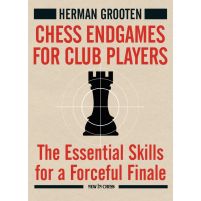In modern times, many games end up in phases in which there is little time on the clock to make quick decisions. Not infrequently, these are endgames in which a winning position must be converted into a win, or a bad/lost position can sometimes still be kept as a draw. For many tournament foxes, the study of endgames is not high on their wish list, but in doing so, they regularly do themselves wrong.
It is sometimes said that pawn endgames are the basis of every other endgame. Because almost always the opportunity arises to convert one endgame into another, and of course that can end up in a pawn endgame. Then you have to assess the evaluation of that remaining endgame. In addition to the necessary basic knowledge, a certain insight is needed to evaluate a pawn endgame properly. And if a player is in a winning position, he also needs to find during the game sometimes the only line (occasionally even the only move!) that will give him victory in which every choice listens very closely. It sounds very difficult, especially when the only Dutch world champion—Max Euwe—once revealed that, according to him, most mistakes are made in endgames.
Still, there is hope: With a few “rules of thumb” and simple “techniques,” we can avoid many mistakes and get more guidance when playing a seemingly difficult endgame to victory or a draw. I have highlighted those rules of thumb and techniques in my book “Chess Endgames for Club Players” to familiarize club chess players with them and give them the right orientation in their endgames.

 In the second example, the other grandmaster (Vassily Ivanchuk) used this special technique, and he beautifully won the full point.
In the second example, the other grandmaster (Vassily Ivanchuk) used this special technique, and he beautifully won the full point.
Conclusions:
If in a pawn endgame one pawn has been able to paralyze two others (as in the first example black has paralyzed the white pawns on a4 and b3 with his pawn on a5; in the second example the black pawn on a4 does the same with the pawns on a3 and b2), the player can work with the “stalemate trick” to force the opponent to play up his b-pawn, giving Black a dangerous passed pawn. One thing is clear: White would have been better off without his extra b-pawn!
